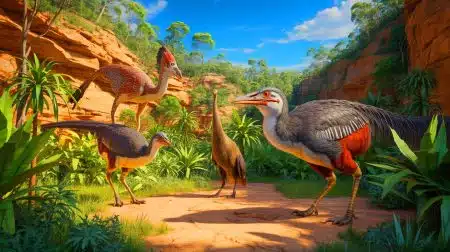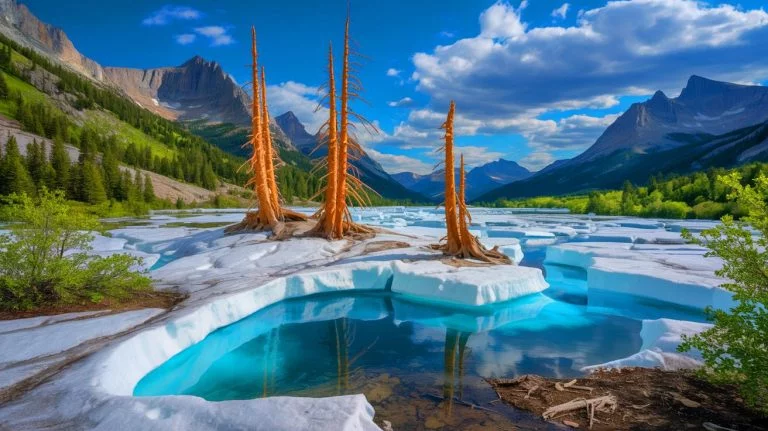| IN A NUTSHELL |
|
In the rugged and often inhospitable high-altitude landscapes of the Rocky Mountains, a remarkable discovery has captured the attention of scientists and historians alike. As climate change causes ice patches to recede, an ancient forest, long buried under ice, is emerging on the Beartooth Plateau. This area, once a thriving ecosystem, now offers an extraordinary glimpse into the past. Researchers are uncovering the secrets of this frozen forest, providing insights into climate shifts and the resilience of ecosystems. This discovery not only highlights historical climatic changes but also serves as a poignant reminder of the current environmental challenges faced by alpine regions.
The Discovery of a Frozen Forest
As the ice melts at altitudes exceeding 10,000 feet in the Rocky Mountains, a hidden forest has begun to emerge. The whitebark pines, preserved in ice for millennia, are being revealed for the first time. This extraordinary find has sparked significant interest among scientists studying climate patterns and ecological history. The Beartooth Plateau, once a thriving forest, now resembles a barren tundra, but this was not always the case. Thousands of years ago, cooler temperatures encased the forest in ice, preserving it for future generations to discover.
“No one had any idea that these patches of ice had been around for thousands of years,” remarked David McWethy, an associate professor at Montana State University.
https://www.sustainability-times.com/climate/theyre-erasing-us-from-the-timeline-scientists-furious-as-the-human-epoch-is-denied-official-status-despite-clear-start-date/
The recent findings, published in the journal PNAS, have opened a window into the past, offering clues about the environment and climate of ancient times. The pristine condition of these trees provides a unique opportunity to study the ecosystem as it existed thousands of years ago.
Climatic Shifts and Preservation
The preservation of these trees is due to a series of climatic events that began over 5,500 years ago. As the climate cooled, volcanic eruptions further contributed to a rapid drop in temperatures, encasing the forest in ice. This sudden preservation has kept the whitebark pines in near-perfect condition, allowing scientists to examine them in detail. The global climate experienced a warm period following the last ice age, which allowed these trees to thrive at higher altitudes than their modern counterparts.
As the ice melts, researchers are finding not just trees but also artifacts that tell the story of human activity in the region. Craig Lee, an assistant professor at Montana State University, discovered a 10,000-year-old wooden spear shaft, suggesting that humans hunted in this once-lush environment. “You go there now and it’s beautiful — it’s a very dramatic landscape — but it’s a little stark,” noted Cathy Whitlock, director of the Paleoecology Lab at Montana State University.
Implications of Climate Change
The melting of the ice patches on the Beartooth Plateau is emblematic of broader climate change impacts. As global temperatures rise, high-elevation areas are experiencing accelerated warming. This has led to the exposure of the frozen forest, providing both scientific opportunities and environmental warnings. While the discoveries are scientifically valuable, they underscore the vulnerability of alpine ecosystems to changing climates. The uncovering of the forest serves as a stark reminder of the delicate balance in these environments.
“These kinds of discoveries are scientifically really interesting, but they’re also a sad reminder of how fragile these alpine ecosystems are to climate change,” said Whitlock.
The melting ice may reveal more about past ecosystems, but it also highlights the urgent need for action to mitigate current climate challenges.
A Window Into the Past
The newly revealed forest offers a rare glimpse into the past, providing insights into ancient ecosystems and climate conditions. As scientists continue to study the preserved trees, they hope to learn more about the historical climate patterns and how life adapted to those conditions. The forest’s emergence tells a story of change, resilience, and adaptation in the face of climatic shifts. The findings have important implications for understanding both past and future climate dynamics.
Philip Mote, an Oregon State University professor, commented on the significance of the find, stating, “I’m sure all sorts of things got buried under the ice.” Indeed, the continued melting of ice patches may uncover more artifacts and provide further data for scientific study. The research conducted on the Beartooth Plateau is a testament to the ever-evolving understanding of our planet’s history.
As scientists delve deeper into the mysteries of this ancient forest, they confront the dual realities of discovery and loss. The melting ice reveals secrets of the past, yet also signals the changes wrought by modern climate challenges. What other hidden histories might be unearthed as the planet’s climate continues to evolve? The emerging forest on the Beartooth Plateau prompts us to consider the stories yet untold beneath the ice.
Did you like it? 4.4/5 (30)







Wow, this is mind-blowing! How did the forest stay so well preserved for thousands of years? 🌲
What an incredible discovery! I can’t wait to see what they find next. 😊
Climate change is revealing so much about our past. Perhaps it’s time we learn from it instead of ignoring it.
Is this the plot of the next Jurassic Park movie? 😂
They found a spear shaft? This is like something out of a history book! 🏹
I’m skeptical. How do they know these trees are thousands of years old without carbon dating?
Can you imagine hiking in the Rockies and stumbling across an ancient forest? Mind = blown. 🤯
I’m curious about what other artifacts might be hidden under the ice. So exciting!
Why hasn’t this been discovered sooner? Were there no signs of it before?
This really changes everything! What else might be uncovered as ice melts?
It’s sad that climate change is causing the ice to melt, but at least we can learn from what’s being uncovered.